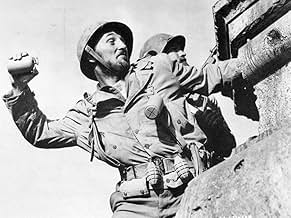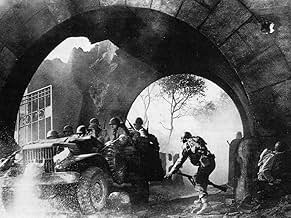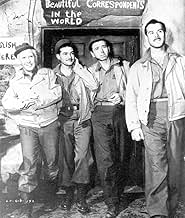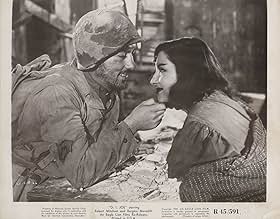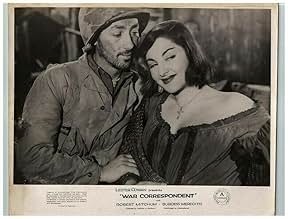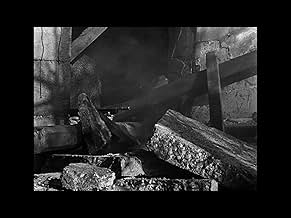NOTE IMDb
7,2/10
4,1 k
MA NOTE
Ajouter une intrigue dans votre langueAt the close of WWII, Pulitzer Prize-winning war correspondent Ernie Pyle travels with, and reports on, the U.S. Army's 77th Infantry Division during their liberation of Italy.At the close of WWII, Pulitzer Prize-winning war correspondent Ernie Pyle travels with, and reports on, the U.S. Army's 77th Infantry Division during their liberation of Italy.At the close of WWII, Pulitzer Prize-winning war correspondent Ernie Pyle travels with, and reports on, the U.S. Army's 77th Infantry Division during their liberation of Italy.
- Réalisation
- Scénario
- Casting principal
- Nommé pour 4 Oscars
- 5 victoires et 8 nominations au total
John R. Reilly
- Private Murphy
- (as Jack Reilly)
William Murphy
- Private Mew
- (as Bill Murphy)
William 'Billy' Benedict
- Pvt. Whitey
- (non crédité)
Michael Browne
- Sergeant
- (non crédité)
Bob Hope
- Bob Hope (Voice on Radio Program)
- (voix)
- (non crédité)
Kenneth Kendall
- Extra
- (non crédité)
Yolanda Lacca
- Amelia, Italian Girl
- (non crédité)
Barney Noto
- Staff Sergeant Barney Noto
- (non crédité)
Tito Renaldo
- Lopez
- (non crédité)
Dick Rich
- Sergeant at Showers
- (non crédité)
William Self
- Pvt. Cookie Henderson
- (non crédité)
Avis à la une
After searching for the best war films all my life, and after seeing so much tripe, I was completely flabbergasted by this film, of which I had heard, but had never seen until last night. Most films made during the Second World War were pure propaganda, all dash and glory, but with little resemblance to real battle. "The Story of G.I. Joe" is the real McCoy, especially considering that it was made near the end of the war. You can feel, taste and smell the muck and fear these men lived with. The dialogue is gritty, the combat scenes, especially of urban fighting bang on. One exceptional and rare scene was of an anti-tank gun crew swinging into action and firing 12 rounds a minute in a town. It was a battle ballet and an example of the lethality of a well-trained and seasoned team. In my opinion, this film ranks with Steven Spielberg's "Saving Private Ryan" as the best film of infantry in combat ever made. In fact, I believe that Spielberg may even have made 'Ryan' as an homage to Wellman's great earlier film; many of the scenes and much of the dialogue is very similar. In 1945, General Eisenhower called 'G.I. Joe' the greatest war film ever made. I'm sure he would say the same thing today. This should be a must-see for every student studying this country's fighting history and every American in uniform should see it.
The Story of G.I. Joe chronicles the experiences of an infantry unit in Italy as told by war correspondent Ernie Pyle, who is played by Burgess Meredith. War weary Robert Mitchum plays the platoon leader. While we can see that the movie was largely made in the studio, the great photography and direction move it along. Cold feet, mud, frustration, and homesickness are effectively demonstrated at the expense of battle scenes.
I rank this film with "The Paths of Glory", "All Quiet on the Western Front", and "A Walk in the Sun"; which I consider to be the most poignant and best acted war or anti-war films. The direction, dialogue, and acting in this film differ in the respect that the bloodshed and action are not graphic but obviously evident. It is certainly better than "Saving Pvt. Ryan", which is too long, pretentious, and relies on gory special effects to entice the younger audience.
The acting in "The Story of G.I. Joe" is realistic (not to be confused with the "method style") and understated.
Burgess Meredith and Robert Mitchum give two of their best performances and I really felt as though this was a portrayal of the every day conditions of the infantryman and not an exercise in false heroics.
I would rate this film a 9 out of 10. And I thank Turner Classic Movies for showing it. It is truly a CLASSIC.
The acting in "The Story of G.I. Joe" is realistic (not to be confused with the "method style") and understated.
Burgess Meredith and Robert Mitchum give two of their best performances and I really felt as though this was a portrayal of the every day conditions of the infantryman and not an exercise in false heroics.
I would rate this film a 9 out of 10. And I thank Turner Classic Movies for showing it. It is truly a CLASSIC.
One of the most fascinating tributes to the foot soldier is this 1945 war film that follows Ernie Pyle, beloved war correspondent, as he treks along through mud and ambushes with a platoon of weary G.I. Joes.
Robert Mitchum earned an Oscar nomination as Lt. Bill Walker and many of the other males in the cast were real combat soldiers who actually participated in the making of the film. The plot is no more than a series of skirmishes the platoon faces on a mission against Nazis in Italy. Burgess Meredith makes Ernie Pyle a likeable human being who wins the trust and affection of the platoon as he trudges with them across marshlands and all of the "up front" activity involved.
Human touches abound without the emphasis on cliches that often abound in war films. Mitchum gives just the right touch to his role as the leader who understands the strain his soldiers are under. The inclusion of a sub-plot involving a soldier anxious to hear the sound of his son's voice on a recording; and a pooch that becomes the mascot for the troops, are touches that give the film added humanity.
There is some editing that seems a bit jumpy in the latter part of the film, as though some cuts were made--but all in all this is a very watchable war film with a close-up look at the men and their courage under fire. A fine tribute also to Ernie Pyle, a famous Pulitzer Prize-winning war correspondent during the dark days of World War II. Highly recommended.
Robert Mitchum earned an Oscar nomination as Lt. Bill Walker and many of the other males in the cast were real combat soldiers who actually participated in the making of the film. The plot is no more than a series of skirmishes the platoon faces on a mission against Nazis in Italy. Burgess Meredith makes Ernie Pyle a likeable human being who wins the trust and affection of the platoon as he trudges with them across marshlands and all of the "up front" activity involved.
Human touches abound without the emphasis on cliches that often abound in war films. Mitchum gives just the right touch to his role as the leader who understands the strain his soldiers are under. The inclusion of a sub-plot involving a soldier anxious to hear the sound of his son's voice on a recording; and a pooch that becomes the mascot for the troops, are touches that give the film added humanity.
There is some editing that seems a bit jumpy in the latter part of the film, as though some cuts were made--but all in all this is a very watchable war film with a close-up look at the men and their courage under fire. A fine tribute also to Ernie Pyle, a famous Pulitzer Prize-winning war correspondent during the dark days of World War II. Highly recommended.
And war was fought in the rain and the mud and the cold....In today's wars fought on film there is very rarely a look at the true living conditions that existed. This movie does not clean up the actors (as most films do). You see here all of the gritty, day-to-day, living during the war. These guys did not clean up every day. This is a good story about WW2. Be sure to see it. 8/10
Le saviez-vous
- AnecdotesThe extras in the film were real American GIs, in the process of being transferred from the war in Europe to the Pacific. Many of them were killed in the fighting on Okinawa--the same battle in which Ernie Pyle was killed by a Japanese machine gunner--never having seen the movie in which they appeared.
- GaffesThe unit Pyle is with--the 18th Infantry Regiment, 1st Infantry Division--never fought in the Italian campaign. After the Sicilian campaign ended, it was brought back to England and began training for the D-Day invasion in Normandy. The 1st Division would eventually spearhead the assault on Omaha Beach.
- Citations
Pvt. Dondaro: If this War don't kill me first, my feet will.
- Crédits fousThere are absolutely no credits at the end of the film, not even the words "The End".
- ConnexionsEdited from La bataille de San Pietro (1945)
- Bandes originalesSilent Night
(uncredited)
Music by Franz Xaver Gruber
Lyrics by Joseph Mohr
Sung by Elfie Mayerhofer on Decca Record
Meilleurs choix
Connectez-vous pour évaluer et suivre la liste de favoris afin de recevoir des recommandations personnalisées
- How long is Story of G.I. Joe?Alimenté par Alexa
Détails
- Date de sortie
- Pays d’origine
- Langues
- Aussi connu sous le nom de
- También somos seres humanos
- Lieux de tournage
- Iverson Ranch - 1 Iverson Lane, Chatsworth, Los Angeles, Californie, États-Unis(marching through countryside just before the "baptism of fire.")
- Société de production
- Voir plus de crédits d'entreprise sur IMDbPro
Box-office
- Budget
- 1 000 000 $US (estimé)
- Durée1 heure 48 minutes
- Couleur
- Rapport de forme
- 1.37 : 1
Contribuer à cette page
Suggérer une modification ou ajouter du contenu manquant

